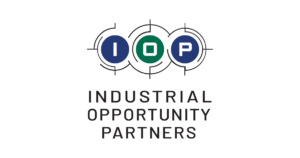Axial and Industrial Opportunity Partners were happy to host eleven middle-market deal professionals for a conversation around M&A in the manufacturing and industrials space this Wednesday. This was week seven of our COVID-19 virtual roundtable series.
This week’s discussion focused on how the management teams of manufacturing businesses are navigating the pandemic, from supply chain disruptions all the way down to people operations. The conversation also covered sourcing in today’s market, the future of manufacturing valuations, and how different transaction structures are faring.
Thank you to Industrial Opportunity Partners as well as the below Axial members who participated in the discussion:

- Phil Fioravante, Operating Principal, Industrial Opportunity Partners (Creative Foam /Edelbrock/GT Technologies)
- Craig Korte, Director of Business Development, Industrial Opportunity Partners
- Norm Young, Operating Principal, Industrial Opportunity Partners (PolyVision & United Poly Systems)
- Mike Bergeron, Managing Partner, Strength Capital
- Ari Fuchs, Managing Director, The DAK Group
- Jessica Ginsberg, Director of Business Development, LFM Capital
- Randy Lederman, Managing Director, Great Rock Capital
- Pitt Means, Co Founder & Managing Director, Berntson Porter & Company
- Bill Overbay, Cofounder & Managing Partner, Stone Road Capital
- Jim Pelusi, Founder & Managing Director, Valero Capital Partners
- Eric White, CEO & Founder, EBB Group
Video
Watch here:
Audio
Stream audio only:
Show Notes
Introductions – 00:00 – 24:50
How are management teams navigating today’s market? – 25:10
- Many management teams have gone through an economic downturn, so they knew the initial steps they needed to take to protect their business
- If you work with end markets that aren’t doing well, which markets can you attack/where is there demand that needs to be served?
- For companies that may have been focused on oil and gas — pivot to telecom, water, electric utilities where you can become an essential business
- PolyVision — a manufacturer of writing surfaces — had antimicrobial products and they’ve pivoted to marketing to healthcare
- How do you acquire demand in new markets?
- Your existing distributors can help drive relevance since you have a relationship and they likely serve many markets
- Call your clients and see what they’re doing: Creative Foam works with multiple end markets including healthcare and automotive, so in anticipation that automotive companies oftentimes pivot during crises, they took their healthcare capabilities to their transportation clients; this allowed them to keep open some of their automotive plants that would have had to otherwise close
- Good motto when approaching potential partners: “Let us help you help others”
- Ford is a leader in making face shields, so Creative Foam is providing the foam that is used in assembling these, and then pivoted further and began making masks in full
- Small cable assembly company that has a client who makes ventilators: in order to avoid a supply chain disaster, they partnered up with a multi-billion dollar company to utilize their supply chains to get lead times on parts down
- Being flexible and listening to employees goes a long way; a lot of workplace absence may not be due to illness, but fear, which can be eliminated. Businesses can adapt by staggering shifts, spacing out employees, providing PPE, etc.
- That said, changes and adaptations in manufacturing are much more significant than those that other sectors, like technology, need to employ
Operating adjustments: are they temporary or long term? – 38:45
- Most are being seen as COVID-specific right now, but this will likely accelerate trends that have already begun (automation, robotics, etc.)
- Management teams have been happy to see how well employees have been accepting a lot of changes
- Some adjustments have actually created increased productivity
- There is a boat-building businesses that has shifted to a schedule where all employees are ultimately only working 3-4 days a week (with increased hours on those days); the employees like it more, and they’re working harder while they’re there
Supply chain disruption – 43:57
- In the near term, everyone understands that whatever needs to be done, needs to be done, but are there longer-term effects?
- A lot of the raw materials are currently only produced in Asia; questions are now arising about alternatives, onshoring, etc.
- Today’s discussions: Can they ship us product? Are they balance-sheet OK? Do they have packaging to ship? Tomorrow’s discussions will be more strategic.
- A lot of supply chain logistics and purchasing issues can be avoided this time around, because after the last recession, businesses have diversified and have multiple options to remain flexible
- The tariffs that were implemented last year with China got the ball rolling and some businesses started to adjust back then
- Customers want the certainly of supply, but they like the low costs that come out of China (and the U.S. will not be able to meet these in the short term)
- There has been more onshoring/nearshoring going on over the past 6-10 months
- Mexico will likely continue to become a hotbed for manufacturing, and then products will only be a truckload away rather than overseas
End-market impacts – 53:20
- Infrastructure and construction have not been affected greatly
- When a lot of the larger airlines and aerospace companies suffer, the smaller providers that feed into them are hit hard as well, so there probably won’t be a lot of strong M&A activity in aerospace until at least Q4
- There is more demand for concrete because projects are getting pulled forward (fewer people on the roads and out and about means that projects move much more quickly)
- The fiscal calendars of municipalities are pretty well baked for the remainder of the year, so there won’t be many problems in the next 6-9 months, rather the issues will begin to arise in 12-18 months
- As people use more technology you need stronger cell-phone service, WiFi, etc., and this ultimately helps different manufacturing sectors
- Wind energy is doing very well because manufacturers can generate more energy, faster
- Manufacturers that service restaurants (produce straws, paper products, etc.) are obviously not doing very well right now
- A lot of automotive sector revenue is driven by new-model creation, so since they’re a year out, they’re not getting hit hard right now; that said, the consumers that buy cars are losing their jobs and are strapped for cash, so demand for cars may be significantly down in the future
- Heavy truck and agriculture end markets are a big concern
- In the past 10-12 days (since stimulus checks began hitting consumers’ bank accounts) some ecommerce businesses tied to hobbies are actually doing very well
The return of employment – 1:07:20
- Everyone hopes that unemployment is a shorter-term issue limited to this time period that management teams need to right their businesses, but realistically, when will they start hiring employees back?
- Travel — which affects airlines, hospitality, etc. — will probably suffer until a vaccine comes out (likely still a year away), and all of the people that work across those industries are consumers who won’t make purchases, which creates a chain reaction
- Management is going to be very cautious about bringing back G&A roles
- This is an opportunity — if you have the means — to increase the quality of employees right now while there are so many individuals who are available
- If you’re part of the PPP program you are on the hook to bring people back or else the funds won’t be forgiven
Growth of robotics and automation – 1:12:00
- This is a full or partial labor substitute that has been looming (and applied in some categories already); how quickly will it accelerate?
- This is going to be a case-by-case scenario; if there are businesses that are going to have to distance employees long term or adjust shifts, they may be pushed to automate certain things
Evolving valuations – 1:14:22
- There’s a lot of talk about multiples being depressed coming out of the pandemic — is this going to be true since it’s no one’s fault?
- Buyers will likely look very differently at structure as well as sharing of risk rather than turning valuations upside down
- It will ultimately come down to how debt providers decide to value companies
- It is the level of uncertainty that is causing these “depressions” because people just don’t know how to normalize the numbers
- It may make sense to look harder at discounted cash flow analysis rather than TTM
- There are bottom feeders on all sides of the markets who are trying to take advantage of businesses and come in with very low offers where they’re not deserved
- If a seller’s business is performing well and they haven’t had major revenue impacts, they shouldn’t be forced to bring down their price because of a broader market impact
- There is a natural reaction in M&A where “benefit of the doubt” disappears for a time, and it greatly affects the deal process
- Business owners should be giving huge amounts of transparency around their customer visibility to ensure that they are eliminating as much uncertainty for the buyer as possible
Axial insights and valuation continued – 1:26:20
- The top and middle of the deal funnel are doing very well right now
- 7-8 LOIs signed on Axial in April, only one closure (that was not levered)
- Anything that needs leverage is not moving
- There is some talk of a “next twelve months” underwriting orientation and bankers are already feeling some pressure to move forward with this model
- How do you allocate risk between a buyer and a seller if you’re looking at the next 12 months?
Structuring deals in process – 1:30:55
- Needs one or both: seller note and equity roll
- Earnouts can become a larger part of a deal so there is more opportunity for an upside if the business grows as previously forecasted
Past Roundtables
Roundtable 1: How Coronavirus Is Impacting Lower Middle Market M&A Activity
Roundtable 2: Portfolio Company Crisis Management
Roundtable 3: Distressed Investing
Roundtable 4: PE Business Development Post-Coronavirus
Roundtable 5: Healthcare M&A Activity and Opportunities
Roundtable 6: A Shift in Investment Strategies Post-Coronavirus


